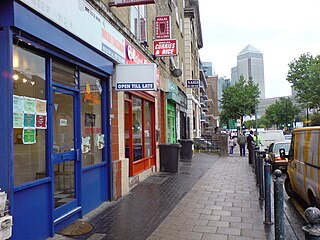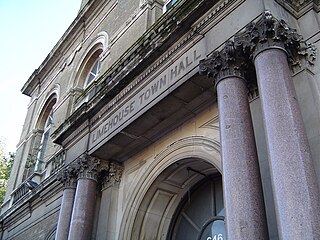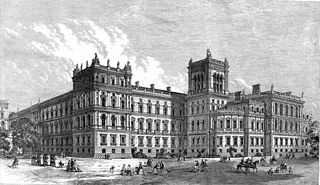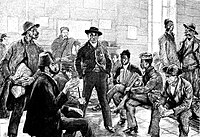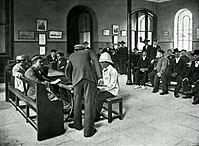
Paul Gustave Louis Christophe Doré was a French artist, printmaker, illustrator, comics artist, caricaturist, and sculptor who worked primarily with wood-engraving.

St Matthias Old Church is the modern name given to the Poplar Chapel built by the East India Company in 1654, in Poplar in the East End of London. The church is designated a Grade II* listed building.

Sir Alfred Comyn Lyall, was a British civil servant, literary historian and poet.

A lascar was a sailor or militiaman from the Indian Subcontinent, Southeast Asia, the Arab world, and other territories located to the east of the Cape of Good Hope, who were employed on European ships from the 16th century until the middle of the 20th century.
British Asians are persons of South Asian descent who reside in the United Kingdom. In British English usage, the term Asian usually refers to people who trace their ancestry to South Asia, the Indian subcontinent in particular ; i.e. modern countries of India, Pakistan, Bangladesh, the Maldives and Sri Lanka.

The Krumen is an ethnic group living mostly along the coast of Liberia and Côte d’Ivoire. Their numbers were estimated to be 48,300 in 1993, of which 28,300 were in Côte d’Ivoire. They are a subgroup of the Grebo and speak the Krumen language.
British Indians are citizens of the United Kingdom (UK) whose ancestral roots lie in India. This includes people born in the UK who are of Indian descent, and Indian-born people who have migrated to the UK. Today, Indians comprise about 1.4 million people in the UK, making them the single largest visible ethnic minority population in the country. They make up the largest subgroup of British Asians, and are one of the largest Indian communities in the Indian diaspora, mainly due to the Indian-British relations. The British Indian community is the sixth largest in the Indian diaspora, behind the Indian communities in the United States, Saudi Arabia, the United Arab Emirates, Malaysia and Nepal. The largest group of British Indians are those of Punjabi origin, accounting for an estimated 45 percent of the British Indian population, followed by other communities including Gujarati, Malayali and Marathi communities.
Sailors’ Society is an international Christian charity working in ports across the world. The organisation has chaplains and ship visitors in 91 global ports, who help seafarers and their families, from all faiths and none, with welfare and practical support.
Henry Beveridge was an Indian Civil Service officer and orientalist in British India.
Bangladeshis are one of the largest immigrant communities in the United Kingdom. Significant numbers of ethnic Bengali and ethnic Sylheti peoples arrived as early as the seventeenth century, mostly as lascar seamen working on ships. Following the founding of Bangladesh in 1971, a large immigration to Britain took place during the 1970s, leading to the establishment of a British Bangladeshi community. Bangladeshis were encouraged to move to Britain during that decade because of changes in immigration laws, natural disasters such as the Bhola cyclone, the Bangladesh Liberation War against Pakistan, and the desire to escape poverty, and the perception of a better living led Sylheti men bringing their families. During the 1970s and 1980s, they experienced institutionalised racism and racial attacks by organised far-right groups such as the National Front and the British National Party.

Mandarin Oriental Hyde Park, London is a five-star hotel, located in the Knightsbridge district of London, owned and managed by Mandarin Oriental Hotel Group. Housed in a historic, Edwardian-style building, the hotel originally opened its doors to the public in 1902 as the Hyde Park Hotel and in 1996 the Mandarin Oriental Hotel Group purchased the property and conducted a full renovation, consequently re-opening in May 2000.
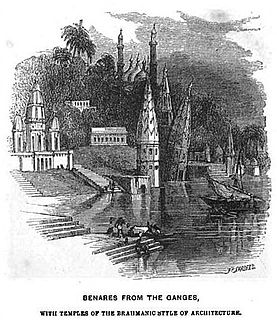
The Rev Dr Robert Hunter LLD was the lead editor of the Encyclopædic Dictionary, which he produced in seven volumes between 1879 and 1888. In addition, he was an ordained minister and missionary for the Free Church of Scotland, and a notable geologist, becoming a Fellow of the Geological Society.

Joseph Austin Benwell (1816–1886) was an English artist, engraver and illustrator. He was primarily an artist in the 'orientalist' style. Many of his paintings and engravings were based on his travels in the Near and Middle East, China and India, often featuring camel caravans, Arab scenes and depictions of Indian life.

Joseph Ray Hodgson was an Englishman hailed as a hero dozens of times after risking his life to save people from drowning, often during a winter storm in the North Sea. He was nicknamed The Stormy Petrel, after the seabirds, because whenever a gale blew up, he could be seen on Sunderland pier searching the skyline for ships in distress in order that he might help. Hodgson was living and working in Sunderland at the same time as the diver, Harry Watts, who was equally famed for saving lives. Hodgson is commemorated in the album titled Stormy Petrel by Sunderland punk band Leatherface.
The Advocate-General of Bombay was charged with advising the Government of the British administered Bombay Presidency on legal matters. The Presidency existed from 1668 to 1947. Prior to 1858, when it was administered by the East India Company, the Advocate-General was the senior law officer of that company and also the Attorney-General of the Sovereign of Great Britain. He was an ex-officio member of the Legislative Council.

The Ayahs' Home, London, provided accommodation for Indian ayahs and Chinese amahs (nannies) at the turn of the 20th century who were "ill-treated, dismissed from service or simply abandoned" with no return passage to their home country. The Home also operated like an employment exchange to help ayahs find placements with families returning to India. It was the only institution of its type in Britain with a named building.
Joseph Walker Jasper Ouseley was a British orientalist and a colonel in the British Army.


